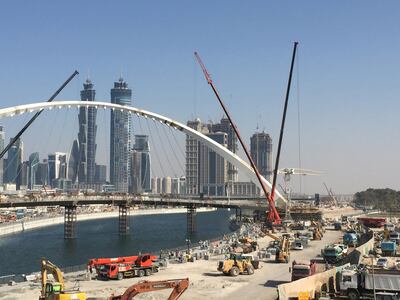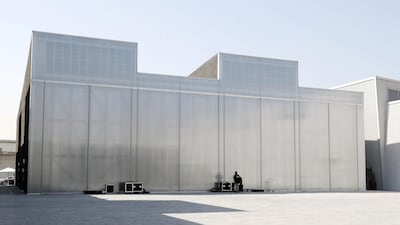As architectural contrasts go, the difference between Alserkal Avenue's warehouse 44 – now rebranded as the d.Academy – and the exhibition it contains couldn't appear more profound.
Industrial, corrugated and contemporary, the warehouse, which is the new headquarters of the Young Architect and Design Programme, contains a modest show that outlines the work of the culture and heritage focused Aga Khan Historic Cities Programme.
Founded in 1992, the AKHCP uses the restoration of architectural masterworks in the Islamic world as a springboard for wider-reaching and long-lasting urban regeneration initiatives that focus as much on education, training and job creation as they do on conservation, restoration and craft.
"We take a whole neighbourhood; we don't just take one monument, fix a dead building and then leave it to die. We identify a catchment area around each site and use its revitalisation to spur wider regeneration," said Shiraz Allibhai, deputy director of the Aga Khan Trust for Culture, after his talk at the d.Academy's inauguration on Saturday.
“These projects are designed with the community. We go in and we sit down with the direct beneficiaries and engage in an intense planning process. What do they need? What would they like to see happen? What are their aspirations for their children and what kind of society and neighbourhood would they like to see them living in, not next year or in two years, but long-term?”
During its 25 years in existence, the AKHCP has overseen the conservation and restoration of Babur’s Gardens – the Bagh-e Babur – in Kabul, the site of the tomb of the first Mughal emperor; the great earthen Mosque of Mopti in Mali; and even Unesco World Heritage Sites such as the Mughal Emperor Humayun’s 16th-century garden tomb in New Delhi and the monumental citadel of Aleppo
in Syria.

At Al Azhar Park in Cairo, teams from the AKHCP have been working with local communities for almost 20 years, alongside its community, social and economically-focused sister agencies, all of which fall under the aegis of the broader Aga Khan Development Network.
“That allowed us to work on early childhood education, on health and vocational training and even on micro-financing and loans,” Allibhai explains. “That also affords us the ability to think proactively, to test, and in some instances to fail, but to come back again. If you have a one-year outlook or mentality, you can’t do that.”
While the d.Academy's inaugural exhibit is limited to a series of posters, the show's championing of a long-term, grass-roots approach to sustainable urban development – so different from the profit-focused model practised locally – has a resonance that gets to the heart of its organisers' mission.
"I've felt for a long time that we think about things on a very superficial level, that we never get down to understanding the depths of our environment, which is why I came up with this initiative," YADP founder Nazneen R Shafi explains. "For us, architecture was always about glitzy imagery, but talking about the values the Aga Khan Historic Cities Programme stands for – sustainable development, quality of life, social improvement, education and training – is very inspiring."
A non-profit educational initiative, the YADP is the product of a collaboration with Ismaili Centre and the Aga Khan Trust for Culture and was launched earlier this year with a month-long exhibition about the 2016 cycle of the Aga Khan Award for Architecture, also hosted at Alserkal Avenue.
At the time, the YADP, which operates under the mentorship of the Aga Khan Award for Architecture – drawing on the organisation for intellectual capital such as materials, speakers, events and exhibitions – had no permanent home, a situation that has now been rectified thanks to the support of Alserkal Avenue.

Aimed at young design professionals and the wider public in Dubai and throughout the Emirates, the YADP aims to fill in what Shafi sees as gaps in the UAE's architectural conversation. It uses talks, workshops, tours and exhibitions, such as a third show, about female Arab architects, that is scheduled to open at the d.Academy in January.
A UAE resident for almost 30 years, during which time she has run projects such as the Sheikha Manal Art Exchange Program and The Sheikha Manal Young Artist Award and curated The Reflective Mirror, an exhibition of work by 23 female UAE-based artists that was held at the UN headquarters in New York in 2010. But Shafi is not the only non-architect who is currently using Alserkal Avenue as a platform for architectural enquiry and debate.
On the other side of Alserkal's cultural campus, Sonia Brewin and Sven Mueller, her business partner in architecture and interior design studio SvenM, are currently doing the heavy lifting required to get Dubai's first architectural biennale off the ground. An Alserkal Avenue-focused affair, Arch.Season'17 is the launch event for the forthcoming Architectural Biennale and is intended to operate as a taster for the main event, which is scheduled for next year.
“The idea is that it will give people who might be keen but not able to see how they could get involved a window into the process,” says Brewin, a Londoner who has called Dubai home for more than a decade.
"[Next year] would involve a full month of programming, but not from us. We would facilitate it, but then we'd hope people would come forward with ideas. Those might be talks, panel discussions, guided tours."
Opening on November 11 and running until the first day of Dubai’s Big 5 construction expo on November 26, Brewin’s “biennalette” will feature architectural majlis discussion sessions; a mapping challenge aimed at teams of student architects from UAE-based universities; and an architecture-focused family adventure day, organised by and hosted at thejamjar community arts space, that will invite children of all ages to design and make their own building for Expo 2020.
Alongside these events, Brewin has organised behind-the-scenes, open-house-style tours of Dubai-based buildings such as Alserkal Avenue's Concrete, which will be led by the building's designer, Iyad Alsaka, a Dubai-based partner with Rem Koolhaas's OMA, and a tour of the Karam Coffee Factory in Al Quoz, which has a glass facade inspired by Renzo Piano's Maison Hermes in Tokyo.
“I’m really keen, as much as possible, to make it a really open platform and not to be didactic. It’s a calendar, there will be themes and then people can choose to put content onto that calendar and we will support people as much as possible,” Brewin says.
“We’ll pick a month, and the idea is that people would then be free to put on the calendar what they wanted to do and as long as it was thematically and practically correct, it will be accepted.”
Like Shafi, Brewin has a background in education, art and curating, and her perspective on architecture has been formed, in part, by her long-term residence in Dubai.
Trained as a fine artist at the Slade in London, Brewin embarked on her career in arts-focused programming by developing the outreach programme for the Prince's Drawing School (since renamed the Royal Drawing School) in London, which brought her to the UAE and Art Dubai, where she worked on arts-based outreach-and-education programmes. Brewin also sees her role as being the facilitator of a richer, more wide-ranging, "joined-up" conversation between architecture and design professionals, and also between the wider public.
“I think when you come here, if you come from outside, you come to work and because you are at work, your focus is not to indulge your intellectual curiosity, maybe your focus is something else – to start a life – and if you have to deliver, you’re mainly driven by what your boss or your client has asked for,” she says.
“But without that scrutiny, we’re all just bumping along, and there isn’t enough pause for reflection and maybe now, after 50 years of development, it’s time to talk about those issues before we get to the centenary.”
For more information about the Young Architect and Design Programme, see their Facebook page. For details about Arch.Season'17 and the Architectural Biennale, visit www.architecturalbiennale.com or see their Facebook page.
___________
Read more:
Dubai's Architectural Biennale: what's your favourite UAE building and why?
Abu Dhabi Art 2017: Key performance events
Lebanese artist Tarek Atoui on capturing the spirit of Mina Zayed
___________

